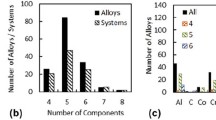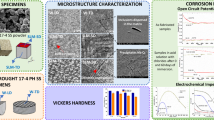Abstract
Rate-controlled sintering and spark plasma sintering are considered the most promising methods to produce dense nanoctructured ceramics. Refractory compounds are used to demonstrate the application of methods for controlling the densification rate and nonlinear heating and loading conditions to produce dense nanocomposites with 30–70 nm grains. The mechanical and tribological properties of ceramics with grains from 50 to 500 nm in size are compared. The effect of increase in the mechanical (5–15%) and tribological (to 50%) characteristics of nanocomposites consolidated by rate-controlled sintering and modified nonlinear spark plasma sintering is studied. Nanocomposites based on refractory nitrides and borides are regarded as promising materials for creating a new generation of cutting tools, as well as wear-resistant ceramics for wide application.









Similar content being viewed by others
References
D. A. Konstantinidis and E. C. Aifantis, “On the anomalous hardness of nanocrystalline materials,” Nanostruct. Mat., Vol. 7, No. 10, 1111–1118 (1998).
R. A. Andrievsky, “State of the art and perspectives in the field of particulate nanostructured materials (Review),” J. Mater. Sci. Technol., 14, 97–103 (1998).
S. Veprek and P. Nesladek, “Superhard nanocrystalline composites with hardness of diamond,” Phys. St. Sol., No. 177, 53–62 (1999).
V. G. Gryaznov, I. A. Polonsky, A. E. Romanov, and L. I. Trusov, “Size effect of dislocation stability in nanocrystals,” Phys. Rev. B., 44, 42–46 (1991).
O. B. Zgalat-Lozynskii, A. V. Ragulya, and M. Herrmann, “Nanostructured composites based on highmelting nitrides,” Silicates Industries, 69, No. 7–8, 147–152 (2004).
D. T. Castro and J. Y. Ying, “Synthesisand sintering of nanocrystalline titanium nitride,” Nanostruct. Mat., 9, 67–70 (1997).
T. Rabe and R. Wasche, “Sintering behavior of nanocrystalline titanium nitride powders,” Nanostruct. Mat., 6, No. 3, 357–360 (1995).
III H. Palmour and D. R. Johnson, “Phenomenological model for rate-controlled sintering,” in: Sintering and Related Phenomena, Gordon & Breach Publishers, New York (1967), p.779.
A. V. Ragulya, “Rate-controlled synthesis and sintering of nanocrystalline barium titanate powder,” Nanostruct. Mat., 10, No. 3, 349–355 (1998).
A. I. Bykov, A. V. Polotai, A. V. Ragulya, and V. V. Skorokhod, “Synthesis and sintering of nanocrystalline barium titanate powder under nonisothermal conditions. Part V. Nonisothermal sintering of barium titanate powders of different dispersion,” Powder Metall. Met. Ceram., 39, No. 7/8, 395–402 (2000).
V. V. Skorokhod and A. V. Ragulya, “Sintering at a controlled rate as a method for regulating the microstructure of ceramics and similar sintered materials,” Powder Metall. Met. Ceram., 33, No. 3/4, 109–117 (1994).
A. V. Ragulya and V. V. Skorokhod, “Validity of the rate-controlled sintering method for consolidation of dense nanocrystalline materials,” in: Proc. 14th Plansee Seminar, Vol. 2, Plansee AG (1997), pp. 735–744.
V. V. Skorokhod and A. V. Ragulya, “Evolution of the porous structure during non-isothermal sintering of fine powders,” Sci. Sintering, 27, 89–98 (1995).
A. V. Ragulya and V. V. Skorokhod, “Rate-controlled sintering of ultrafine nickel powder,” Nanostruct. Mat., 5, No. 7, 835–844 (1995).
O. B. Zgalat-Lozynskii, V. V. Skorokhod, A. V. Ragulya, et al., “Sintering of refractory compound nanocrystalline powders. Part 2. Non-isothermal sintering of titanium nitride powder,” Powder Metall. Met. Ceram., 40, No. 11–12, 537–581 (2001).
I.-Wei Chen and X.-H. Wang, “Sintering dense nanocrystalline ceramics without final-stage grain growth,” Nature, 404, 168–171 (2000).
O. B. Zgalat-Lozynskii, A. V. Ragulya, and M. Herrmann, “Rate-controlled sintering of nanostructured titanium nitride powders,” Series II: Mathematics, Physics and Chemistry, 16, 161–167 (2000).
O. B. Zgalat-Lozynskii, A. V. Ragulya, and M. Herrmann, “TiN-based nanocrystalline ceramics,” Key Eng. Mat., 206–213, 2181–2184 (2001).
J. R. Groza, J. D. Curtis, and M. Kramer, “Field-assisted sintering of nanocrystalline titanium nitride,” J. Am. Ceram. Soc., 83, No. 5, 1281–1283 (2000).
M. Nygren and Z. Shen, “On the preparation of bio-, nano- and structural ceramics and composites by spark plasma sintering,” Sol. St. Sci., 5, 125–131 (2003).
P. Angerer, L. G. Yu, K. A. Khor, et al., “Spark-plasma-sintering (SPS) of nanostructured titanium carbonitride powders,” J. Europ. Ceram. Soc., 25, No. 11, 1919–1927 (2005).
O. B. Zgalat-Lozynskii, M. Herrmann, and A. V. Ragulya, “Spark plasma sintering of TiCN nanopowders in non-linear heating and loading regimes,” J. Europ. Ceram. Soc., Vol. 31, 809–813 (2011).
O. B. Zgalat-Lozynskii, A. V. Ragulya, M. Herrmann, et al., “Structure and mechanical properties of spark plasma sintered tin-based nanocomposites,” Archives Metal. Mat., 57, No. 3, 853–858 (2012).
G. Bernard-Granger and C. Guizard, “Spark plasma sintering of a commercially available granulated zirconia powder: I. Sintering path and hypotheses about the mechanism(s) controlling densification,” Acta Mat., 55, 3493–3504 (2007).
M. Schulz, I. Herrmann, I. Endler, et al., “Nano Si3N4 composites with improved tribological properties,” Lubrication Sci., 21, 69–81 (2009).
M. Herrmann, Z. Shen, I. Schulz, et al., “Silicon nitride nanoceramics densified by dynamic grain sliding,” J. Mater. Res., 25, No. 12, 2354–2361 (2010).
S. Gregory, “Rohrer measuring and interpreting the structure of grain-boundary networks,” J. Am. Ceram. Soc., 94, No. 3, 633–646 (2011).
A. M. Glezer, N. A. Shurygina, E. N. Blinova, at al., “Grain boundary engineering as a way to achieve the ultimate (theoretical) strength of nanocrystals,” Deform. i Razrush. Mater., No. 11, 1–7 (2011).
Acknowledgements
The author thanks M. Herrmann and Ya. Rotel (IKTS, Germany) for assistance in SPS experiments, V. T. Varchenko (FIPMS, Ukraine) for assistance in experiments on ceramics wear-resistance, and A. V. Ragulya (FIPMS, Ukraine).
Author information
Authors and Affiliations
Corresponding author
Additional information
Translated from Poroshkovaya Metallurgiya, Vol. 53, No. 1–2 (489), pp. 26–40, 2014.
Rights and permissions
About this article
Cite this article
Zgalat-Lozinskii, O.B. Nanocomposites Based on Refractory Compounds, Consolidated by Rate-Controlled and Spark-Plasma Sintering (Review). Powder Metall Met Ceram 53, 19–30 (2014). https://doi.org/10.1007/s11106-014-9583-5
Received:
Published:
Issue Date:
DOI: https://doi.org/10.1007/s11106-014-9583-5




